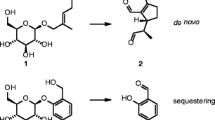Abstract
Cardenolides were looked for in 17 chrysomelid beetles belonging to 11 genera from three subfamilies, and they were found only inChrysolina andChrysochloa species (Chrysomelinae, Chrysolinini). The food plants of these insects are not known to produce cardenolides. TheChrysochloa and mostChrysolina species secrete a complex mixture of cardenolides, butChrysolina didymata secretes a single compound, andChrysolina carnifex, none. Several quantitative and perhaps qualitative differences were observed in the patterns of cardenolides produced by far distant populations of bothChrysolina polita andC. herbacea, collected in either France and Belgium, or Greece. These differences remain constant from one generation to the other, whatever the food plant is, and appear to be genetic. InC. polita from Greece, the pattern is unchanged after four generations bred in the laboratory onMentha ×villosa, which is known to be without cardenolides. In adults, the cardenolides are released with the secretion of the pronotal and elytral defensive glands, but in the larvae which lack the defensive glands, cardenolides are also produced. The total amount of cardenolides and the complexity of their mixture increases through the life cycle of the insects. The six main cardenolides secreted byC. coerulans were identified as: sarmentogenin, periplogenin, bipindogenin, and their corresponding xylosides.C. didymata secretes only sarmentogenin.
Similar content being viewed by others
References
Berti, N. 1968. Quelques observations sur la biologie dePhaedonia circumcincta Sahl et description des stades larvaires et nymphal.Bull Soc. Entomol. France 73:114–127.
Blessington, B., andMorton, I.M. 1970. Mass spectrometry in cardenolide chemistry. I.Org. Mass Spectrom. 3:95–99.
Blum, M.S., Wallace, J.B., Duffield, M.S., Brand, J.M., Fales, H.M., andSokoloski, E.A. 1978. Chrysomelidial in the defensive secretion of the leaf beetle,Gastrophysa cyanea Melsheimer.J. Chem. Ecol. 4:47–53.
Brown, P., Bruschweiler, F. andPettitt, G.R. 1972. Massenspektrometrische Untersuchungen von Naturprodukten: Cardenolide.Helv. Chim. Acta 55:531–543.
Deroe, C., andPasteels, J.M. 1977. Defensive mechanisms against predation in the Colorado beetleLeptinotarsa decemlineata Say.,Arch. Biol. 88:289–304.
Durette, P.L., andHorton, D. 1971. Conformational studies on pyranoid sugar derivatives. The conformational equilibria of the D-aldopyranose tetraacetates and tetrabenzoates.J. Org. Chem. 36:2658–2669.
Fechtig, B., von Euw, J., Schindler, O., andReichstein, T. 1960. Die Struktur der Sarmentoside. Glykoside vonStrophantus sarmentosus P. DC.Helv. Chim. Acta 43:1570- 1584.
Fieser, L.F., andFieser, M. 1959. Steroids, p. 730, Reinhold. New York.
Fujii, Y.,Shimada, K., andNambara, T. 1976. Isolation of cardiac steroid 3-sulphates from the skin of Japanese toads.Chem. and Ind. (London) 614.
Garb, G. 1915. The eversible glands of a chrysomelid larva,Melasoma lapponica.J. Entomol. ZooJ.. 8:88–97.
Hollande, A.C. 1909. Sur la fonction d'excrétion chez les insectes salicicoles et en particulier sur l'existence des dérivés salicylés.Ann. Univ. Grenoble 21:459–517.
Holloway, J.K. 1964. Projects in biological control of weeds,in pp. 650–670, P. Deback and E.I. Schlinger (eds.).Biological Control of Insects, Pests and Weeds. Chapman and Hall, London.
Höriger, N., Zivanov, D., Linde, H.H.A., andMeyer, K. 1970. Weitere Cardenolide ausCh'an su.Helv. Chim. Acta 53:2051–2059.
Jones, T.H., Meinwald, J., Hicks, K., andEisner, T. 1977. Characterization and synthesis of volatile compounds from the defensive secretions of some “daddy longlegs” (Arachnida: Opiliones:teiobunum sp.)Proc. Natl. Acad. Sci. U.S.A. 74:419–422.
Katz, A. 1948. Konstitution des Sarmentogenins.Helv. Chim. Acta 31:993–1004.
Kedde, D.L. 1947. The chemical investigation of digitalis preparations.Pharm. Weekblad. 82:741–757.
Kochetkov, N.K., andChizhov, O.S. 1966. Mass spectrometry of carbohydrate derivatives.Adv. Carbohydr. Chem. 21:39–93.
Lemieux, R.U., andStevens, J.D. 1966. The proton magnetic resonance spectra and tautomeric equilibria of aldoses in deuterium oxide.Can. J. Chem. 44:249–262.
Lewbart, L., Wehrli, W., andReichstein, T. 1963. Die Cardenolide vonGongronemagazense (S. Moore) Bullock.Helv. Chim. Acta 46:505–517.
Meinwald, J., Jones, T.H., Eisner, T., andHicks, K. 1977. New methylcyclopentanoid terpenes from the larval defensive secretion of a chrysomelid beetle (Plagiodera versicolora).Proc. Natl. Acad. Sci. U.S.A. 74:2189–2193.
Pasteels, J.M. 1976. Evolutionary Aspects in Chemical Ecology and Chemical Communication.Proc. XVth Int. Cong. Entomol, Washington D.C., pp. 281–293.
Pasteels, J.M., andDaloze, D. 1977. Cardiac glycosides in the defensive secretion of Chrysomelid beetles: Evidence for their production by the insects.Science 197:70–72.
Rees, C.J.C. 1969. Chemoreceptor specificity associated with choice of feeding site by the beetleChrysolina brunsvicensis on its food plantHypericum hirsutum, J. De Wilde, and L.M. Schoonhoven (eds.).In pp. 565–583,Insect and Host Plant. North-Holland Publishing Company, Amsterdam.
Rodriguez, E., Towers, G.H.N., andMitchell, J.C. 1976. Biological activities of sesquiterpene lactones.Phytochemistry 15:1573–1580.
Rothschild, M., von Euw, J., andReichstein, T. 1970. Cardiac glycosides in the oleander aphid,Aphis nerii.J. Insect Physiol 16:1141–1145.
Rothschild, M., von Euw, J., andReichstein, T. 1973. Cardiac glycosides (heart poisons) in the polka-dot mothSyntomeida epilais Walk. (Ctenuchidae: Lepidoptera) with some observations on the toxic qualities ofAmata (=Syntomis)phegea L.Proc. Soc. London, Ser. B 183:227–247.
Singh, B., andRastogi, R.P. 1970. Cardenolides. Glycosides and genins.Phytochemistry 9:315–331.
Speiser, P., andReichstein, T. 1947. Konfiguration des Periplogenins und des allo-Periplogenins.Helv. Chim. Acta 30:2143–2158.
Tamm, C. 1956. Neuere Ergebnisse auf dem Gebiete der glykosidischen Herzgifte: Grundlagen und die Aglykone.Fortsch. Chem. Org. Naturstoffe 13:137–231.
Tori, K., andAono, K. 1965. NMR studies on steroids. X. δ20(22)-Cardenolides.Ann. Rep. Shionogi Res. Lab. 15:130–137.
Wigglesworth, V.B. 1968. The Life of Insects. New American Library. New York.
Yamaguchi, K. 1970. Spectral Data of Natural Products, pp. 227–230, Elsevier, New York.
Author information
Authors and Affiliations
Rights and permissions
About this article
Cite this article
Daloze, D., Pasteels, J.M. Production of cardiac glycosides by chrysomelid beetles and larvae. J Chem Ecol 5, 63–77 (1979). https://doi.org/10.1007/BF00987688
Received:
Revised:
Issue Date:
DOI: https://doi.org/10.1007/BF00987688




